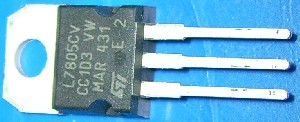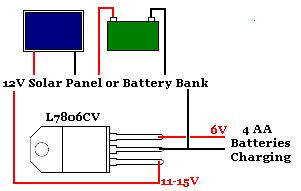In a previous article we covered how the LM317T voltage regulator chip can be used to obtain a fixed voltage from a variable supply. Looking at a typical renewable energy system 12V battery bank, the output from the batteries can rise to 15V+ when they are being heavily charged. In order to power lower voltage devices from such a battery bank, some kind of voltage regulation is essential.
LM317 / LM317T
The LM317T is a very common voltage regulator (available from the REUK Shop) used to obtain a fixed voltage of between 3 and 40 Volts set using a couple of resistors. Click here to read up on using the LM317T to regulate voltage.
Fixed Voltage Regulation
While the LM317T is relatively simple to use, having to add a couple of resistors adds unnecessary complexity if you just want a fixed voltage of say 5 Volts at around 1 Amp – for example, for a simple solar battery charger powered from a 12V solar panel or 12V battery bank.

Permanently fixed voltage regulators are available which require no resistors – the output voltage is internally fixed. The L7800 Series of positive voltage regulators can handle an output current of up to 1.5 Amps, and regulators are available with output voltages of 5, 5.2, 6, 8, 8.5, 9, 12* (pictured above), 15, 18, and 24 Volts.
* A couple of volts are dropped (i.e. lost) in these regulators , so the 12V regulator cannot be used reliably with a 12V battery bank to obtain a fixed 12V ouput.
These fixed regulators are available cheaply (well under £1 each) and are very simple to use in practice.

Using an L7806CV Voltage Regulator
The L7806CV is a voltage regulator from ST which will provide a fixed output of 6 volts (5.75-6.25V in reality) from an input voltage from 9V to 35V. Therefore, it it suitable for use for a 4 AA Battery Charger to be powered from a 12V solar panel or battery bank.

Further Information
The L7800 Series Positive Voltage Regulators Technical Specifications (PDF) can be downloaded here.